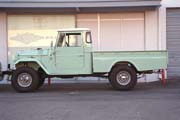 The
stock FJ45 long-wheel-base (LWB) truck has a 116" wheelbase as well as
a considerable amount of the box and frame positioned aft of the rear axle.
The biggest problem with FJ45s is that the cab is extremely cramped. I decided
to push my limited body-work skills to the maximum and make an extended-cab.
I didn't want to shorten the bed like others have done, so I decided to lengthen
the frame -- hence the name of stretched limo. I elected to extend the cab and
frame by 16".
The
stock FJ45 long-wheel-base (LWB) truck has a 116" wheelbase as well as
a considerable amount of the box and frame positioned aft of the rear axle.
The biggest problem with FJ45s is that the cab is extremely cramped. I decided
to push my limited body-work skills to the maximum and make an extended-cab.
I didn't want to shorten the bed like others have done, so I decided to lengthen
the frame -- hence the name of stretched limo. I elected to extend the cab and
frame by 16".
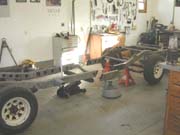 I
found a good FJ40 frame in the form of a parts rig that was for sale real cheap.
I purchased the whole rig, sold the cab and other body parts, and then proceeded
to cut up the frame. For the cringing purists, the rig had no title, so there
was not much that I could do with it in terms of restoration or building of
a new vehicle. In order to obtain the necessary extension, I cut 16" out
of the central portion of the frame. The cuts were made on a 40 degree angle.
Here is the FJ45 frame cut and the frame inserts ready to be welded in:
I
found a good FJ40 frame in the form of a parts rig that was for sale real cheap.
I purchased the whole rig, sold the cab and other body parts, and then proceeded
to cut up the frame. For the cringing purists, the rig had no title, so there
was not much that I could do with it in terms of restoration or building of
a new vehicle. In order to obtain the necessary extension, I cut 16" out
of the central portion of the frame. The cuts were made on a 40 degree angle.
Here is the FJ45 frame cut and the frame inserts ready to be welded in:
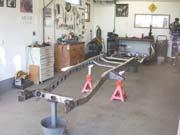 Here
is the frame with the inserts welded in. The frame additions will result in
a wheelbase of 132" without any changes in the spring or axle configuration.
This is now a looooong limo frame.
Here
is the frame with the inserts welded in. The frame additions will result in
a wheelbase of 132" without any changes in the spring or axle configuration.
This is now a looooong limo frame.
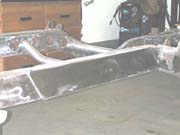
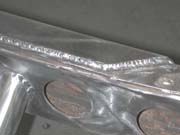 After
welding in the frame inserts, I further strengthened this area of the frame
by adding a 33" long sleeve on each side. The frame sleeves are 10 gauge
steel. I used a hydraulic brake at a local fabrication shop to make the sleeves.
The sleeves fit tightly over the existing frame and are welded on three sides
of the frame:
After
welding in the frame inserts, I further strengthened this area of the frame
by adding a 33" long sleeve on each side. The frame sleeves are 10 gauge
steel. I used a hydraulic brake at a local fabrication shop to make the sleeves.
The sleeves fit tightly over the existing frame and are welded on three sides
of the frame:
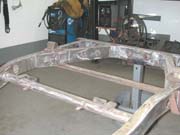 Although
Toyota always called the FJ45 LWB a "one-ton" truck, the frame is
nowhere as strong as the domestic equivalents, especially at the rear of the
frame where it is all open C-channel of approximately 10 gauge in thickness.
In an attempt to strengthen the rear of the frame, I boxed in the entire rear
of the frame. Again I used 10 gauge sheet metal. In order to save a bit of weight
and provide access to the central portion of the frame, regular holes were cut
on the inside wall of the frame.
Although
Toyota always called the FJ45 LWB a "one-ton" truck, the frame is
nowhere as strong as the domestic equivalents, especially at the rear of the
frame where it is all open C-channel of approximately 10 gauge in thickness.
In an attempt to strengthen the rear of the frame, I boxed in the entire rear
of the frame. Again I used 10 gauge sheet metal. In order to save a bit of weight
and provide access to the central portion of the frame, regular holes were cut
on the inside wall of the frame.
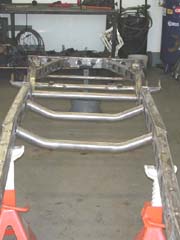 The
OEM transfercase crossmember was also removed and replaced by three new tubular
crossmembers. One of the new members is straight and the other two have been
bent in order to provide additional room for the driveshaft. The crossmembers
are 2" o.d. 0.120" wall HREW tube. The crossmember in the front is
currently just tacked in place. I will wait until final placement of the drivetrain
to fix its final position.
The
OEM transfercase crossmember was also removed and replaced by three new tubular
crossmembers. One of the new members is straight and the other two have been
bent in order to provide additional room for the driveshaft. The crossmembers
are 2" o.d. 0.120" wall HREW tube. The crossmember in the front is
currently just tacked in place. I will wait until final placement of the drivetrain
to fix its final position.